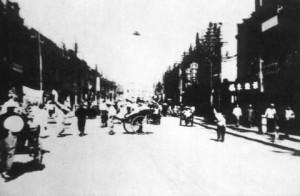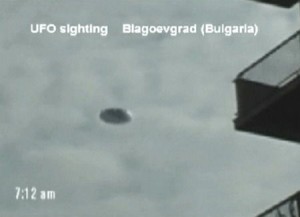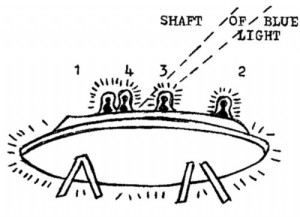Warning: strlen() expects parameter 1 to be string, array given in /home2/orbman69/public_html/wp-includes/functions.php on line 262
(Last Updated On: )
THINK ABOUTIT SIGHTING REPORT
Date: July 1, 1947 to September 16, 1947
Sighting Time:
Day/Night:
Location: CHITOSE AAB, HOKKAIDO, JAPAN., MEW Radar Station, FUKUOKA, JAPAN.
Urban or Rural: –
No. of Entity(‘s):
Entity Type:
Entity Description:
Hynek Classification: RV (Radar / Visual) Observation supplemented with radar.
Duration:
No. of Object(s):
Height & Speed: In excess of 500 mph. (435 knots) Altitude: 9000 ft. or higher.
Size of Object(s):
Distance to Object(s):
Shape of Object(s):
Color of Object(s):
Number of Witnesses:
Source:
Full Report
SECRET HEADQUARTERS, ARMY AIR FORCES
Washington
MEMORANDUM FOR ASSISTANT CHIEF OF AIR STAFF – 2
SUBJECT: Radar Pick-ups of High Speed Targets in the Far East.
1. This recapitulation of three radar pick-ups of high speed, targets in the Far East from 1 July 1947 to 16 September 1947 has been prepared to present graphically the targets and locations reported, together with an estimated evaluation of this activity.
2. Paraphrased below are the incidents referred to with Air Intelligence Division comments for each incident. Attached as Enclosure 1 to this memorandum is a map plotting the referenced incidents:
a. 1 July 1947
Source: GGA Unit, CHITOSE AAB, HOKKAIDO, JAPAN.
Speed: In excess of 500 mph. (435 knots) Altitude: 9000 ft. or higher.
Remarks; A target was picked up 16 miles north of the base on a course of 180 degrees. (Point A’). The GCA unit immediately called the tower and asked if any aircraft were operating north of the field. At this instant of this radio transmission, the target reversed course to 360 degrees and was tracked out to a range of 28 miles (Point 3′). The target then changed course to 240 degrees arid was tracked out 6 miles. (Point C’) where it again reversed course to 060 degrees and returned to the original point 28 miles north of the base (Point 3′). The target then changed course to 360 degrees and faded out of range (Dotted line).
Comments; The nearest known operational U.S.S.R. air base to the north of Chitose AAB is Otomari on southern Ostrov Sakhalin at a range of 234 nautical miles from Chitose AAB. This base is classified as having temporary runways of 4500 – 6000 foot length. Base contains a large aviation gasoline tank farm with a pipeline to Korsakov Harbor which is capable of handling tankers.
Headquarters of the U.S.S.R. Air Force on Karafuto is located in the Toyohara area about 24 miles to the north of Otomari.
page 2
b. 28 August 1947
Source: MEW Radar Station, FUKUOKA, JAPAN.
Speed: 390-415 knots
Altitude: 1500 feet.
Remarks: A target was picked up in orbit at a range of 26-30 nautical miles on a bearing of.20 to 30 degrees (Point A). Target then took a heading of 023 degrees and was tracked to a range of 54 nautical miles where it faded (Point3).The target was in a climb on this outbound course and the weather at the time was such that the climb would have to be made on instruments.
c. 16 September 1947
Source: MEW Radar Station, FUKUOKA, JAPAN.
Speed: 840 – 900 mph (730-780 knots)
Altitude: 10,000 – 20,000 feet.
Remarks: A target was picked up at a range of 89 miles on a bearing of 040 degrees (Point C). Target was tracked on an incoming course to a range of 19 miles and a bearing of 045 degrees (Point D) at which point it faded out.
Comments; The nearest known operational U.S.S.R. air bases are on the east coast of Korea at 39° 10′ North Latitude and 127 degrees 29′ East Longitude and Haeju on west coast of Korea at 38° 02′ North Latitude and 125 degrees East Longitude. The range to these oases from Fukuoka is 360 nautical miles. Genzan is classified as having permanent runways of 4500-6000 foot length, and was highly operational by the Japanese. Haeju has one runway of approximately 4000 foot length, probably surfaced. It is therefore reasonable, to assume that the U.S.S.R. is utilizing the facilities at these bases to the utmost, since the location is strategically between Vladivostok to the north and the U.S. occupied areas of Korea to the south. A recent report from the U.S. XXIV Corps, evaluated F-3, states “a new type aircraft on Haeju airstrip North Korea. “‘This aircraft emitted black smoke on take-off, but was not identified as jet propelled.”
d. No U.S. aircraft were reported operating in the areas where the targets were picked up.
3. Preliminary conclusions based on the above information indicates:
a Great stress was given by the reporting agency to the high degree of proficiency of the radar operators and controllers in each caae. An operator of even moderate proficiency would have no trouble in differentiating between a target and weather phenomena. Frontal activity as seen °on a radar screen would show depth while the reflection from a meteor exists for such a short period of time that it would probably not be distinguishable from static interference. Therefore, it appears that the incidents are not due to natural phenomena.
page 3
b. In the case of the pick-up on 1 July 1947 it was indicated as being more than one object. The size was comparable to that of the response received from four P-51 type aircraft. When this target initially reversed course at point A’ it broke up into two responses and then again merged into one large response on its outbound course. The track of this target, if aircraft, could indicate a photographic mission.
c. The sighting on 28 August 1947 was probably a jet-propelled aircraft. Soviet jet aircraft are believed to have performance sufficient for such a mission.
d. The speed indicated in the last report seems unreasonable for piloted aircraft since it was well into the supersonic range. The target, if an aircraft, would require an extremely large fuel supply for this speed. If rocket propelled, it is hard to visualize its operation for a long enough period of time to enable it to return to its base. The cable report of this last sighting indicated that further details, including weather, would follow. Upon receipt of this information a better evaluation may be possible.
4. Present information does not permit a definite evaluation that all objects reported were either aircraft or airborne missiles but does support the conclusion that they were not natural phenomena.
JAMES F. OLIVE
Colonel, G.S.C.
Chief, Air Intelligence Division
AC/S-2



Related Reports
Warning: strlen() expects parameter 1 to be string, array given in /home2/orbman69/public_html/wp-includes/functions.php on line 262
1 min read
2357- 2258 BCE: Japan Sightings
Warning: strlen() expects parameter 1 to be string, array given in /home2/orbman69/public_html/wp-includes/functions.php on line 262
1 min read
0460 CE: Katsuragi Mountain, Japan Encounter
Warning: strlen() expects parameter 1 to be string, array given in /home2/orbman69/public_html/wp-includes/functions.php on line 262
3 min read
1803: Harayadori Japan Sighting